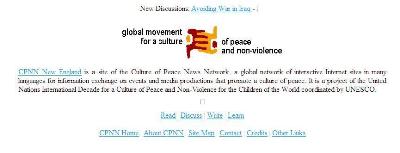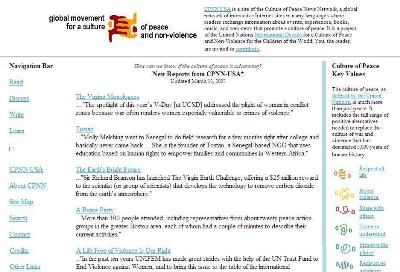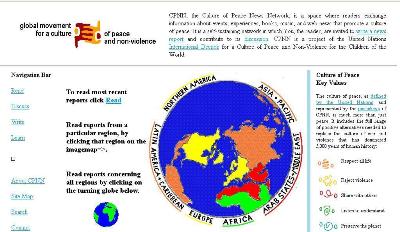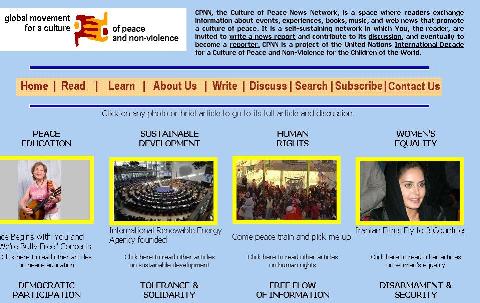Stories
The Culture of Peace News Network continued
Missions for the Culture of Peace
Travels with Lindsay in the USA
Vacations with Lindsay in the Caribbean
Vacations with Kiki in Reunion
The geometry of time
* * *
When I returned with Lindsay to the United States after my retirement from UNESCO in June 2001, I put my energies and hopes into the Culture of Peace News Network (CPNN) which I had begun at UNESCO (see CPNN-1..
Seeing how the Cable News Network (CNN) was very successful at carrying the news of the culture of war, I thought I could do the equivalent with CPNN for the culture of peace. I said that CNN was an abbreviation of CWNN, the "culture of war news network" and joked that just as newspapers maintained a full set of obituaries prepared for the deaths of famous people, so, too, CWNN, somewhere in Atlanta, kept updating a full set of future wars, so that as soon as one broke out they could immediately broadcase its full pre-history.
I conceived of CPNN as a virtual community of people who would write articles for CPNN and who would edit awkwardly or badly-written articles by others to put them on line. It was based on the system that my team had developed at UNESCO with contracts to Di Bretherton of Australia for the technical details based on Perl scripting and the training procedures developed by Di and Zeynep Varoglu working with me at UNESCO.
I conceived that CPNN would grow as separate websites in different languages and for different regions based on the same principles and translating and exchanging articles among themselves. I started small as CPNN New England.

Home page of CPNN-England
(click on image to enlarge and for Read page in addition)
At first it seemed to be working. After visiting me and Di in Paris, Takehiko Ito mounted a site in Japanese which worked for many years. Di established a beautiful site in Australia which she ran for several years and included articles from contacts in China. In Moscow, Katerina Saliagina continued to develop a sub-site of the UNESCO site there as a CPNN affiliate and she put several articles on line which I translated an put on the English-language site which I was running.
Over the years, many others (in Canada, England, France, Brazil, Cyprus, etc.) promised to set up other CPNN sites, but it proved to be too difficult for them, and gradually I realized that the time had not yet come for a global CPNN. So I concentrated on the development of the English-language site.
I ran many workshops around New England that generated articles and trained moderators. Several were at Wesleyan University in conjunction with a course that I ran in 2002 on the culture of peace. Some of the students in that course continued to work with CPNN, contributing their own articles and moderating those of others. These included Joe Yannielli, Ben Oppenheim, Charley McNally and Saori Imaizumi (who later did some work on CPNN-Japan with Takehiko). Other workshops were conducted at events in Hartford (with Mary Lee Morrison and Helen Raisz), at the University of Connecticut in Storrs (with Adam Kaloides and others) and at the high school in my hometown of Branford. My archives include the rather elaborate documents from several of these workshops.
I tried various ways to involve more people. I set up a discussionboard in association with the site so that people could discuss their articles. I even establishing a bulletin board where organizations could post upcoming events. But over time each of these efforts failed to "take off" and gradually the site received fewer and fewer contributions. There were many visitors, but they came for the most part through search engines, read one page and then went on with their surfing.
At the end of 2002 I tried another tack by expanding the site to all of the USA and sending out a monthly bulletin to a large mailing list that I had culled from the news releases of peace organizations such as United for Peace and Justice. This, too produced a momentary increase in articles, but not for long.

Home page of CPNN-USA
(click on image to enlarge)
For a number of years I had the collaboration of Joanne Tawfilis who ran the Art Miles project and who solicited articles and involved students in Southern California. At one point she promised to involve the national network of United Nations Associations in the effort, but that did not materialize.
By 2007 it was clear that CPNN-USA was not growing and that it was not being joined by other CPNN sites around the world, so I decided to use the mailing list established from the 2005 World Report on the Culture of Peace and transform CPNN from CPNN-USA to CPNN-WORLD. I started with a new and much sexier home page as shown below.

Home page of CPNN-WORLD
(click on image to enlarge)
Again there was a brief increase in activity, and I ran moderator training workshops in several countries, but again participation began to wane after a while. This was despite the fact that I described new stories and invited readers to contribute more in the bulletin that went out every few months to thousands of organizations, including all those from the 2005 World Report and 2006 Youth Report. Finally by 2009 I had more or less given up on CPNN and I simply used it to provide news from city initiatives as proposed in the strategy published in my new book, World Peace through the Town Hall.
In 2011, I undertook a new renaissance of CPNN with the help of the youth team of the 2010 World Report on the Culture of Peace. I re-designed the site using slideshows with the agreement that the youth team would be reporters. As of writing this in April 2011, it is still too early to know if this new approach will work any better than previous approaches. Here is a snapshot of the new frontpage:

Home page of the 2011 version of CPNN
(click on image to enlarge)
 |
Stages
1986-1992
Fall of Soviet Empire
1992-1997
UNESCO Culture of Peace Programme